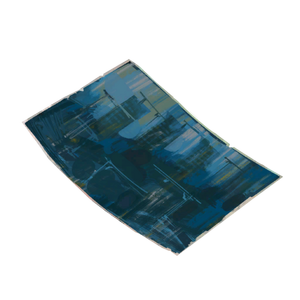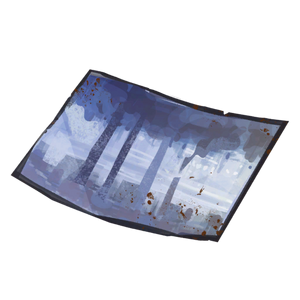| Line 104: | Line 104: | ||
===La Delta=== |
===La Delta=== |
||
| − | In a narrow sense, La Delta refers to the financial district. Twenty-two kilometres from the centre of the world, the district includes some of the most important areas in Revachol: The Bank of the World building (called a soldering iron), which contains the INSURCOM - Coalition Government Insulindian Mission Command - on the bottom floors.<ref>[[Joyce Messier]]</ref> |
+ | In a narrow sense, La Delta refers to the financial district, west of Revachol West. Twenty-two kilometres from the centre of the world, the district includes some of the most important areas in Revachol: The Bank of the World building (called a soldering iron), which contains the INSURCOM - Coalition Government Insulindian Mission Command - on the bottom floors.<ref>[[Joyce Messier]]</ref> |
In a broader sense, it refers to the delta of the River Esperance. Faubourg, the district immediately adjacent to the river that divides the city are about as well-off as Revachol West, that is, not very. The People's Pile, a Type U particle generator (a nuclear reactor, basically) that started construction during the Commune and entered service after its collapse. The occupation government did not help and the ad hoc construction failed due to a faulty emergency valve. The resulting damage took out the turbine and the fuel containment vessel, leading to a massive radioactive discharge into the Esperance. Emergency Relief Brigade, a volunteer, self-organized cleanup crew, tried to salvage the situation, only succeeding in working themselves into an early, cancer-ridden grave.<ref name="BNR">[[Bird's Nest Roy]]</ref> Despite the failed reactor, Faubourg expanded and by '51 it's a seemingly endless stretch of urban sprawl. |
In a broader sense, it refers to the delta of the River Esperance. Faubourg, the district immediately adjacent to the river that divides the city are about as well-off as Revachol West, that is, not very. The People's Pile, a Type U particle generator (a nuclear reactor, basically) that started construction during the Commune and entered service after its collapse. The occupation government did not help and the ad hoc construction failed due to a faulty emergency valve. The resulting damage took out the turbine and the fuel containment vessel, leading to a massive radioactive discharge into the Esperance. Emergency Relief Brigade, a volunteer, self-organized cleanup crew, tried to salvage the situation, only succeeding in working themselves into an early, cancer-ridden grave.<ref name="BNR">[[Bird's Nest Roy]]</ref> Despite the failed reactor, Faubourg expanded and by '51 it's a seemingly endless stretch of urban sprawl. |
||
| + | |||
===Nearby regions=== |
===Nearby regions=== |
||
:'''Ozonne''' |
:'''Ozonne''' |
||
Revision as of 21:43, 14 November 2019
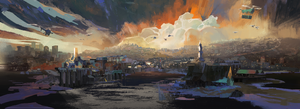
View of Revachol from the bay.
Revachol (RE-va-shol) is the disgraced former capital of the world, divided into zones of control under foreign occupation -- half a century after a failed world revolution.[1] Revachol is located on the island of Le Caillou in Insulindian isola.
When middle class people talk about foreign places, they like to talk about “contrasts”. Travel magazines, financial journals, regional reports on the news... it's all about those contrasts. And what they mean by “contrasts” is that most people are pornographically poor while a few are obscenely wealthy. That's what they mean by contrasts. East of the river, monetary organizations promote regional stability, west of the river cops collect tare for cash and junkies shake so hard their bones come loose from their sockets.
There is no city in the world with more contrasts than Revachol. The broken, magnificent, disgraced former capital of the world. A great sky on fire, reflecting off broken glass. Revachol the Suzerain, Revachol the Commune, Revachol the Administrative Region where all forms of government have failed. Revachol the Resolver, the answer to the great burning questions of history. How should we live? Will the horror ever end?
History
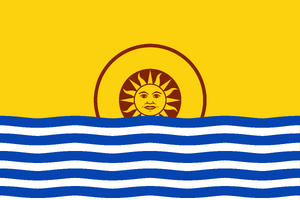
Flag of the Suzerain of Revachol.
Revachol was originally founded in the Dolorian century, 380 years ago, during the early colonization of the Insulindian archipelago by the Kingdom of Suresne (modern day Sur-La-Clef). Originally settled by sheepherders coming in from Suresne, the strategic location of Revachol Bay led to its quick development and eventually independence from Suresne. The former colony became a kingdom and an economic superpower.
Revachol's economy relied on a diverse range of territories producing commodities for export. These included apricots from the Empire of Safre, marble and archeological treasures from Ile Marat (the ancestral name of Iilmaraa), sugar from the Semenine Islands and cocaine from Supramundi and Saramiriza, tinged a characteristic magenta color. In fact, the oversupply of cocaine forced the suzerain to look for new markets in the middle of the last centuryfor all the cocaine it was producing, and it settled on Safre. Introduced under exclusive contract, the suzerain created an extremely valuable captive market for an extremely addictive product.[2] It had other holdings: Tioumoutiri was a Revacholian colony on Iilmaraa. The suzerainty's population was mostly Iilmaraan areopagites -- up to 97%. The region was known for its tobacco export. Hence the name.[3]
Ruling dynasties
Filippe II the Opulent was born congenitally deformed and proved to be a catastrophe. While he did expand Revachol's fortifications, including the establishment of a Sea Fortress to guard entrance to the bay, he kept squandering the national treasury on gold and ceremonial weaponry. He was also a perpetual philanderer, which culminated in syphilis. He passed it as a sort of twisted legacy on to his son, and Filippe III was born with congenital syphilis. Furthermore, he established the traditional Filippan use of cocaine - Regnum Cocainum - ostensibly for clarity of vision, to aid in their work. This thinly-veiled excuse for cocaine dependency poorly obscured the vast amounts of wealth he wasted on the drug, consuming it at an alarming rate.
In fact, Filippe III was even brought into this world with the help of cocaine -- the court medic administered a dose to his mother when she was in labour. The son wasn't much better than the father, earning the nickname Squanderer from supporters and "vicious syphilitic murderer" from detractors. The third and greatest of the filippian kings of Revachol, allegedly had his bedroom converted into a treasure chamber where an unfathomable amount of krugerrands, bars of gold, ornate weaponry, armor and various chalices covered the floor and even the walls. There were whispers the king slept on a huge pile of gold like an obese dragon, instead of a bed like a normal person would. He sired an even more monstrous king, Filippe IV, simply called the Insane.
The following line of kings fared a bit better better, with Filippe V and Guillaume the Lion capping off the monarchy. The drive to expand did not die down: In the last decades of the Last Century, the monarchy carried out the Ikeira Operation, a seven-year campaign during which Suzerain Guillaume's army forcefully united the people in the south-eastern part of Le Petit Continent, collectively known as the Ikeira tribes, under the Revacholian banner. However capable he was as a leader, Guillaume the Lion, saw the writing on the wall and abdicated in favor of his nephew, Frissel. While his uncle moved abroad to Graad, living out a long and productive life as a venture capitalist, Frissel the First found himself alone before the unstoppable march of history.[4]
Revolution
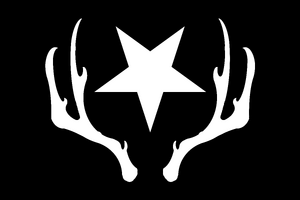
The star-and-antlers, symbol of the Revolution.
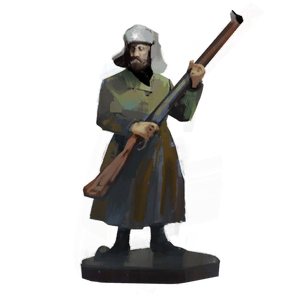
A figurine of a Revolutionary, showing the usual garb of the ICM.
The Antecentennial Revolution happened right at the start of this century, in Graad in '02 and then spread like wildfire. The Revolution bloomed thanks to dissatisfaction with the Suzerain's rule: Numerous underground pamphlet-printing operations sprung up in the years leading up to and during the Revolution, helping ferment dissent and rally people against the King. The forces of the communists and the anarchists, known as the blacks and the whites respectively, organized under the collective banner of Insulindian Citizens Militia at the outset. Frissel attempted to quell it in one brilliant military move. Unfortunately, Frissel sent the least suitable person to lead the crackdown, his cousin, Drysant. He marched his men in a neat column right up to the communards' position, promptly leading to a massacre at the hands of the well-prepared and well-armed revolutionaries. Drysant himself lost his jaw, but survived the battle thanks to one of the royal carabiners.[5]
However, the loyalists, or browns, as they were called, fought valiantly, too loyal to be considered sane. The bloody fighting continued until '06, leading to the establishment of the Commune of Revachol. The communists of the Parti Communiste d'Insulinde set about remaking society in the wake of a brutal war that consumed two million lives and deposed the wretched Suzerain. Some changes took the form of repressions, other of reforms. Revachol communists started 'Ask Revachol', a radio show used to address civil issues. However, the Commune would be short-lived: The Coalition formed soon after, interested in ending the commune and the revolutionary experiment. Probing attacks launched on Revachol were supported by loyalists, who fed intel to the Coalition, provided diversions as Coalition aerostatics entered Revacholian airspace, and launched guerilla attacks during the bombings.[6]
The game of cat and mouse lasted until '08. To prevent the attacks, communards set fire to the oil wells so that no one could enter the isola, halting trade, poisoning the air and the water, creating oil slicks for miles and miles. However, it only delayed the inevitable. Coalition's land forces invaded Revachol in a massive amphibious operation called the Beachhead. The Coalition artillery bombarded Revachol's coastal defences for a week using Lafayette cannons, then launched the landings at three points simultaneously: Martinaise, Delta, and Stella Maris. The Coalition aerostatics had to reroute because of the fires, but when they got there, the line simply broke. Martinaise simply collapsed. Many revolutionaries deserted. Some came over to Coalition-side, some just ran. That sealed the fate of the Revolution. The communard government surrendered, although the Communist Party did not. For their services, the loyalists were summarily disposed of and even executed 'by mistake'.[6]
Under occupation
The city came under Coalition occupation as a Special Administrative Region, divided into zones controlled the Coalition's member states from INSURCOM: the Insulindian mission command. INSURCOM is the theater command for the combined armies of Occident and Graad, with Mesque volunteers. The post-revolutionary decade was a disaster for the Coalition Government, as not only much of the western parts of the city remained leveled, the Coalition was busy fighting communist holdouts and carrying out mass executions, then bulldozing the bodies into mass graves. Loyalists and innocent civilians were routinely caught up in the executions. However, the approach proved successful: A combination of mass executions, brutal policing, bounties, and good old snitching eventually extirpated communists from Revachol together with much of the infrastructure.[7]
Revachol in the Twenties was hell, especially on the west side of the river: gang warfare, a botched privatisation scheme, a nuclear pile meltdown, all resulted in the he division of the city into zones de contrôle under foreign nations: the Mesque Zone, the Occident-Graad zone, and the International zone. The International encompassed Revachol districts west of the river, and was the site of a decade-long urban war that saw swathes of Revachol West leveled, offshore platforms set alight, though overall, it was considered an improvement over the hellish years of '08 - '19.[4][8]
Still, no nation wanted to claim responsibility. The Revachol Citizens Militia was founded to step in and keep the order, allowing Revacholians to maintain the peace and give them a semblance of self-governance. Indeed, the RCM restored peace where the Coalition failed (an unforgivable sin). However, it allowed the Coalition to proceed with its plans: INSURCOM made sure that free market capitalism imposed by the foreign powers persisted, and enabled the opening of the local job market to large numbers of cheap foreign workers, allowing the rich to make a killer profit. In the meantime, the poor were crushed beneath the heels of foreign occupiers and much of Revachol - especially districts like Martinaise - were left to rot, with no meaningful restoration or rebuilding attempts.[6]
The Thirties saw a global economic boom. Revachol East took the lion's share of the profits and transformed itself into the world's largest tax haven -- with the international community's blessing.[4] This decade also saw a massive rise in the popularity of foreign music, as Semenese disco took hold.[6] Although the West benefited from it somewhat, the losses were offset by numerous problems. The greatest of these came in '36, the People's Pile on the Esperance failed, leading to widespread radioactive contamination of the river and pushing Revachol West ever further into decline.[9]
The Forties dispelled the economic like a bucket of ice cold water on the face of a drunk: A market mirage fuelled by cocaine and quantitative easing, sending the economy into a recession and a pan-isolar hangover.[4]
In '52, unbeknownst to most, the world is facing extinction within 28 years due to the encroaching pale. On March 5th, the only man capable of doing something about it, Harrier Du Bois, wakes up on the floor of the Whirling-In-Rags hostel cafeteria in Jamrock, Martinaise. He is the last Revacholian hero.[8]
Revachol is most likely doomed.[8] If not, it will be destroyed circa '74 by an atomic device.[10]
Geography
Revachol sits on La Caillou a fertile island in the middle of the Insulindian Ocean, the world's largest body of water; in the eye of a great archipelago called Face-A-La-Mer. The island is fertile, self-sufficient and able sustain up to 200 million people; it also occupies a strategic position in the middle of the Insulindic ocean -- the world's connective tissue. At its heart lies Suzerain Revachol, with a radius of 80 kilometres, the crown jewel of the Insulindian isola. On its southern end, in the Old-Old South, Monte Martin, checkered farmland, and the winding Esperance that cuts the city in half.[11]
The city is divided into three major regions: East Revachol and West Revachol (International Zone), between them: La Delta. As a city under military occupation, there is a substantial military presence on land, sea, and air. Coalition airships guard over the twenty one cordons of the Special Administrative Region. However, the most important zone of control is the Bay of Revachol. Vast and deep, over 1200 m at its deepest, the bay is crisscrossed by huge cargo ships bearing company logos: Wild Pines, ZAMM, Moriyn. They carry eight percent of the global trade. At the farthest reaches of the Bay of Revachol -- the shadow of Coalition Warship Archer, on perpetual patrol duty, ready to unleash artillery fire if any were to rise up against the market.[11]
Underwater, iron helmets have sunk deep into the sand and the mud. Helmets of soldiers. And their fingerbones, too. And clavicles. Littering the ocean floor.[11]
Revachol East
By '21, a little more than a decade after the war, the eastern bank was already fully renovated.[12] The hillsides were lush with gardens and residences, especially in its most desirable district, Le Jardin. Houses with gardens rise along the mountainside, up to Saint-Batiste where two of the world's five largest companies keep their headquarters.[8]
Other districts include the Stella Maris district - one of the three landing points during the Coalition invasion - and Saint-Batiste, which gives its name to Saint-Batiste Pharmaceuticals. Known as slums before the Revolution, Saint-Batiste is where Contact Mike, the world-renown boxer, was born and rose through adversity and brain trauma to become one of the greats of sports history. Saint-Batiste is also where the Saint-Batiste Dinghy Races were conceived. Originally intended as a biennial civic pride celebration (and cash cow), they only took place twice, in '31 and '33.[13]
Revachol West
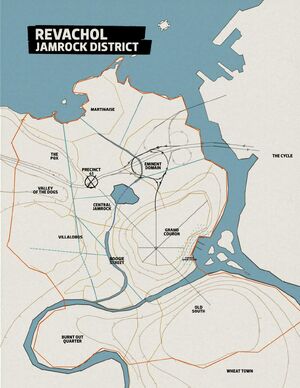
A map of Jamrock, or Revachol West.
West of the river, it's funky-baby holocaust time all day every day. It's the International Zone, which means: no one gives a shit. It's no one's business. In East-Jamrock, wild animals roam the valley at night – giraffes that escaped from the Royal Zoo 50 years ago. Giraffes – even-toed ungulates from the savannah. The local kiosque chain Fritte employs a private army of 2000 men to guard its properties in Jamrock and Faubourg. That's how bad the crime rate is – you need a private army to run a kiosque chain.[8]
Districts
Jamrock is a district of Revachol West comprised of the following quarters: Martinaise, Pox, Villalobos, Central Jamrock, Grand-Couron, Old South and the Valley of the Dogs.
A great district, filled with a chessboard of wooden houses, 80.000 living souls. Firetraps as far as the eye can see -- from Main Street to Grand Couron, from Precinct 41 to Boogie Street forking into the distant horizon. Before the Revolution it was one of the greatest districts in Revachol, benefiting from Wild Pines investment and presence. In fact, the district was founded and developed by Wild Pines to support the cargo terminals used to transport goods across the known world. The Industrial Harbour rapidly became one of its most important parts, but it was the waterfront that became the main attraction for tourists. In '98, Rue de Saint-Ghislaine was teeming with parasol-wielding bourgeoisie and Wild Pines flags buttress the walkway.[14]
They didn't realize that within ten years Martinaise would become a gutted ghetto, scarred by the Antecentennial Revolution and half-burned down by the Coalition's artillery bombardment and subsequent landings. Martinaise's most prominent feature, a twelve story tenement called Capeside apartments, became an allegory: Eight of its twelve floors were destroyed by artillery fire and turned from a desirable urban address into little more than a rundown slum inhabited by drug addicts, disillusioned communists, and broken families. The Greater Revachol Industrial Harbour rises up from among the devastation, an artificial mountain range filled with metal shipping container. A place of wealth, casting a long shadow of the poverty around. Beyond it lies La Drisienne, King Dris's Passenger Harbour, filled with cruise ships flanked by dock arms. The distributary of Esperance separates it from Grand Couron - and further from the East.
There is a perpetual competition between RCM precincts regarding Martinaise: Nobody wants to take responsibility for the district, and so it remains in a gray area. RCM patrols are extremely rare, with the Dockworkers' Union picking up the slack and acting as de facto police force and government for the district.
- Pox
Once a park, a place for reflection and recuperation for the patients of the Old Military Hospital. In the 20s it was used as a quarantine centre during a measles outbreak that killed many children. Most everyone has avoided the hospital and surrounding park ever since. The Pox is completely wild now. Evergreen thickets covered in snow and industrial dust. Feral dogs and even wolves roaming in packs. The police try to keep the deepest corners cordoned off. Heavy drug users do slip through and hole up in the Old Military Hospital, hoping to find something to get high on among the hastily abandoned supplies. Or just to overdose in peace.[11]
- Villalobos
Named after a peninsula in Mesque, this district is inhabited primarily by emigres from the isola. It's known for its large housing projects and Mesque gangs, notable for their culture, rather than mere presence - it's par for the course west of the river. Villalobos was notable for a certain mural case handled by Harrier Du Bois. Nine thousand people subjected to the mural's message -- all of Lakeside (Central Jamrock) and Villalobos, plus half of the Eminent Domain -- participated in a vote whether to remove or preserve it.[15]
There's an entire street walled off and turned into a poppy field by a deified gangster called The Mazda, while his mortal enemy La Puta Madre exclusively employs former narcotics officers to farm his own fields.[8]
- Central Jamrock
The heart of the Jamrock Quarter, it's a bit more pleasant than the rest of western Revachol, though not by much. Its defining feature is a lake on the eastern edge of the district, formed when a mainline pipe burst in the early 20s. It is also where Precint 41 is located, for better or worse. Although the district has amenities such as a public library, it has its share of problems, such as damaged residential buildings that cannot be repaired properly in the absence of a municipal government. In one notable case, a building with 200 tenants is at the risk of collapse, but there are no real authorities to repair it or provide alternate housing. The best they can hope for is a burned-out building with mold and rot throughout, if someone even notices the damage.[16]
Below Precinct 41 there's a kebab merchant called Kuklov, in the market across the bridge. He makes kebabs that make you immortal if you can eat three and survive. It's the fly larvae. Some RCM officers believe eating it will make them immune to food poisoning.[17]
Although thought extinguished, traces of communist thought remain in Jamrock, usually among the youth and the odd cafe, where they gather to cope with the brutality of life under foreign occupation and the iniquities of capitalism.[18]
- Eminent Domain
A working class district between Central Jamrock and Esperance, Domain is a place of hard people and hard lives. Its defining feature is the 8/81 motorway running over the district of Jamrock, a monstrous shadow, high above the firetraps of the Domain, old workers' barracks steadily being torn down to expand the highway. Concrete pillars rise up from the midst of the dilapidated wooden houses. The 8/81 separates Martinaise from Jamrock. Vehicles whoosh past one another day and night, while those who reside in the labyrinthine alleyways beneath the motorway attempt to carry on with their lives in the snow and the slush. [8]
On the horizon, barely visible, the hazy machinery of the harbour. Life in the Domain is even worse off than in Martinaise. The cold air is stiff from the fumes of motor carriages and lorries roaring overhead.[19]
- Grand Couron
Just east of Jamrock. Grand Couron is a place of impossible contrasts, an island of riches among the desolation of western Revachol. Much of the recovery in Couron is thanks to the thirties, the boom years. As such, it's one of the nicest districts in Revachol West: Tall and handsome buildings rise from the riverside: steel, iron and yellow limestone, with cloud shadows sliding on the facades.[20] One of its most notable places is the Grand Couron Arena, where, in March '52, Arsane-Luc Edelbrock sends the Samaran heavyweight champion, Kostya Mjasnok Kostunica, to the floor.
Not all places of Grand Couron are as well-off. One of these spots is an ill-advised residential area overlooking the Jamrock Quarter, completed by '37. 13-story buildings lined the hillside like sarcophagi, acting like a punctuation mark at the end of the boom years - in '39 the project failed catastrophically, leaving behind an opiate and hepatitis B infested slum.[21]
- Burnt Out Quarter
A stretch of burned, ruined buildings.
- Coal City
Located in shadow of Mount Saint-Martin, Coal City was a boom town, back when coal extracted from countless shafts near the city was needed to power Revachol. By '52 it's a wretched heap of closed-down mines even west of Jamrock, on the dusty slope of Monte Martin. The remotest possible area of Revachol, no one even wants to exploit those people any more. The reason for the collapse is simple: The coal was supplanted by petroleum from the ocean floor and hydropower from the Esperance. Everything crumbled. These days, only the weakest remain in Coal City. Their hopes of getting rich linger in the defunct shafts under their feet.[11]
Below the old mines lies L'Ossuaire Municipal, Revachol's underground cemetery. Les petits rats brave the underground passageways, trying to get to Le Royaume, a vast network of dungeons and burial chambers, where the filippian kings were interred, with their doctors and their admirals. Mausoleums, burial chambers, leaf gold still remains on the Double Door of the Morning. The whole network dates back three centuries. Children under 14 go underground, looking for artefacts to sell to foreign museums -- and for fabled relics. They hunt after rubies, melchiorite, lapis lazuli plundered from Safre and Seol during the time of the Suzerain. In the burial chambers of the kings: Grand Old Filippe, Guillaume II, and even in the mausoleum of Filippe the Opulent.[11]
Two kilometres underground, in a winding shaft along whose walls mirrors have been placed so that daylight may eternally fall upon the richest of all the kings. The mausoleum contains untold quantities of gold -- and that special, purest-of-the-pure magenta cocaine favoured by Revacholian royalty.[11]
Few *petits rats* return from the shafts -- and even fewer find what they're looking for. A small child steps out of a black tunnel, with silver trinkets in her pockets. All around her, white snow on the extinguished coke furnaces, and on the weather-worn shacks, where fathers beat their sons after drinking. The snow melts on your fingers, turning to water.[11]
La Delta
In a narrow sense, La Delta refers to the financial district, west of Revachol West. Twenty-two kilometres from the centre of the world, the district includes some of the most important areas in Revachol: The Bank of the World building (called a soldering iron), which contains the INSURCOM - Coalition Government Insulindian Mission Command - on the bottom floors.[22]
In a broader sense, it refers to the delta of the River Esperance. Faubourg, the district immediately adjacent to the river that divides the city are about as well-off as Revachol West, that is, not very. The People's Pile, a Type U particle generator (a nuclear reactor, basically) that started construction during the Commune and entered service after its collapse. The occupation government did not help and the ad hoc construction failed due to a faulty emergency valve. The resulting damage took out the turbine and the fuel containment vessel, leading to a massive radioactive discharge into the Esperance. Emergency Relief Brigade, a volunteer, self-organized cleanup crew, tried to salvage the situation, only succeeding in working themselves into an early, cancer-ridden grave.[9] Despite the failed reactor, Faubourg expanded and by '51 it's a seemingly endless stretch of urban sprawl.
Nearby regions
- Ozonne
An archipelago 80 to 100 kilometers - two days' travel - away from Revachol. Its moneyed residents, used to posh restaurants and upscale boutiques, rarely have reason to visit Martinaise. Ozonne was also a staging area for the Coalition in '08. Hundreds of ships prepared here for the Landing, while powerful artillery aerostatics were anchored to the sea floor and bombarded the city for three days straight, to soften the defenders and civilians for occupation. Its major cities are the Fond de l'Air and Virmandeux.
- Resurrection
Way beyond Martinaise -- a popular spa destination for ample-bodied Ozonne kids with equally ample pockets, established in '18.
- Laurentide
Located on the other end of Le Caillou, its major city is Deora-of-the-Seven-Seas.
Politics
Following the collapse of the Revolution and the mass executions of communists, Revachol became a neoliberal's paradise: A tax haven and a vital hub for cheap labor and overseas shipping. Since the fall of the Revolution, the Coalition has maintained a grip on the city under the the Emergency, Wayfarer, and Aliments Acts -- three pieces of legislation keeping the city in a laissez-faire stasis to the benefit of foreign capital. The Wayfarer Act is one of the most perfidious, designed to limit the authority of local institutions. Part of it prohibits the RCM from requesting most documents and licenses without permission from a Coalition representative.[23]
Death penalty remained a staple of criminal "justice" in Revachol since time immemorial. Under the Suzerain and the commune, the preferred method was a firing squad. The Coalition's occupation forces are more fond of the electric chair. Those who dodge the executioner's blade still have to deal with lengthy prison sentences in the River Esperance Correctional Facility (nicknamed Reunion), an infamous military prison.
Factions
- Coalition: The occupying force of overseas nations that imposed a brutal, exploitative capitalist economy on Revachol.
- Revachol Citizens Militia: A volunteer police force organized with the tacit approval of the Coalition.
- Dockworkers' Union: A labor union, socialist faction, and/or corrupt mob depending on who you ask. Considered the de facto government of the abandoned Martinaise.
- Loyalists (a euphemism for “fascists”): A defeated faction of Revacholian royalists who blame all the evils of the world on the failed Revolution, 50 years ago. Their philosophy is best summed up as follows: "If good, kind king Guillaume were still around, he'd drive the moneylenders and the homo-sexuals back into the ocean! Once we were an octopus that straddled the world, sucking up natural and human resources from Iilmaraa to South-East Seol. The city state that screwed the whole world. Then deranged commies pushed the king under a street car and lost the civil war to foreign intervention, damning us to financial servitude."[8]
- Communists: The communards, mostly dead. Okay, one is still alive and teaches cultural theory at the Ecole Normale de Revachol, east of the river. And there's talk of two more employed by a failed radio-game studio. But the rest are all dead, bulldozed into mass graves after the Coalition Army retook Revachol in '08.[8]
Miscellaneous
- Decorations
- The Croix de Bravoure, cross of valour, was the highest battlefield decoration in Suzerain's armed forces, awarded for exceptional bravery in the line of duty in service of king Frissel the First.
- The Setting Sun was a decoration used to distinguish seasoned combat veterans in service of king Frissel the First during the revolution.
- Culture
- When it comes to cigarettes, contemporary Revacholians prefer Drouin (a local blend from the southern islands) or Astra, the legendary cigarette from Graad. Tioumoutiri is favoured by older men for its paper filter tips, sweet smell, and added tar.[24]
Notes and references
Notes
- ↑ 005 is Revachol SAR.[1]
References
- ↑ 1.0 1.1 Disco Elysium - Encyclopedia
- ↑ Board game Suzerainty
- ↑ Encyclopedia
- ↑ 4.0 4.1 4.2 4.3 Joyce Messier
- ↑ René Arnoux
- ↑ 6.0 6.1 6.2 6.3 René Arnoux and Gaston Martin
- ↑ Iosef Lilianovich Dros
- ↑ 8.0 8.1 8.2 8.3 8.4 8.5 8.6 8.7 8.8 Welcome to Revachol Devblog
- ↑ 9.0 9.1 Bird's Nest Roy
- ↑ Shivers: "IN 22 YEARS, THE FIRST SHOT WILL BE FIRED. NOT A SHOT FROM A GUN -- AN ATOMIC DEVICE THAT WILL LEVEL ALL OF ME. ALL OF ME."
- ↑ 11.0 11.1 11.2 11.3 11.4 11.5 11.6 11.7 Shivers
- ↑ Postcard Le Jardin '21
- ↑ Lena, the Cryptozoologist's wife
- ↑ Postcard Martinaise '98
- ↑ Ledger of Failure and Hatred
- ↑ THE COLLAPSING TENEMENT case in the Ledger of Failure and Hatred
- ↑ Encyclopedia and Shivers
- ↑ Noid?
- ↑ Shivers
- ↑ Postcard Couron '33
- ↑ Postcard Grand Couron '37
- ↑ Joyce Messier
- ↑ Encyclopedia
- ↑ Encyclopedia

